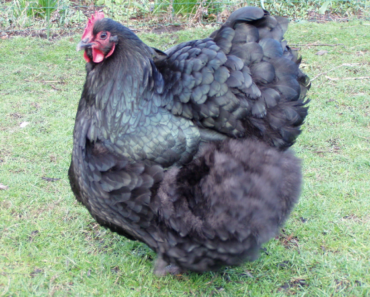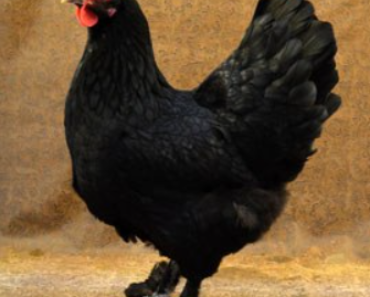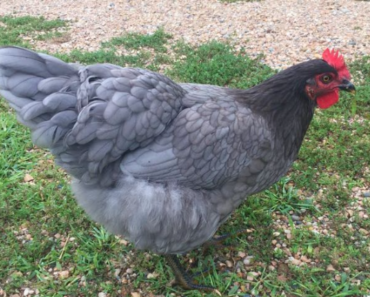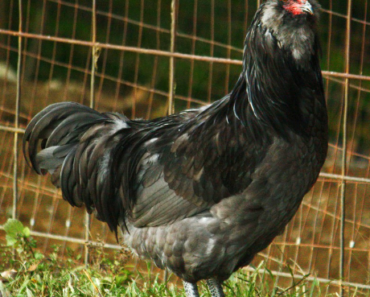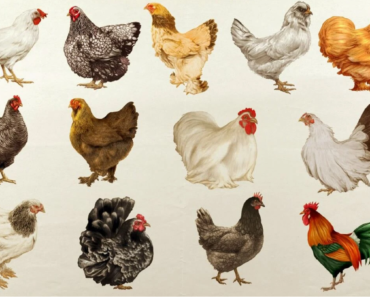Contents
- 1 Discover the Beauty and Benefits of Rhode Island Red Chicken in the World of Poultry
- 2 History and Origin of Rhode Island Red Chicken
- 3 Characteristics of Rhode Island Red Chicken
- 4 Care and Management of Rhode Island Red Chicken
- 5 FAQ
- 5.1 How does the Rhode Island Red chicken differ from other chicken breeds in terms of egg production and meat quality?
- 5.2 What are the ideal living conditions and diet requirements for raising Rhode Island Red chickens to maximize their growth and health?
- 5.3 Can the Rhode Island Red chicken tolerate extreme climates, such as hot summers or cold winters, and what measures can be taken to ensure their well-being in such conditions?
- 5.4 Related Posts

Rhode Island Red chicken: Discover the fascinating history and characteristics of this iconic breed. Renowned for its deep red feathers and exceptional egg-laying abilities, the Rhode Island Red is a beloved choice among backyard chicken enthusiasts. Explore this breed’s origins, temperament, and tips for successful care and raising.
Discover the Beauty and Benefits of Rhode Island Red Chicken in the World of Poultry
Rhode Island Red Chicken, also known as the RIR, is a fascinating breed in the world of poultry. Its striking appearance and numerous benefits make it a popular choice among chicken enthusiasts.
The Beauty of Rhode Island Red Chicken: The RIR is characterized by its deep mahogany red plumage, which exudes natural beauty. Its feathers have a stunning lustrous sheen, making it a visually appealing breed to have in your flock.
The Benefits of Rhode Island Red Chicken: Apart from its aesthetic appeal, the RIR offers several practical advantages. It is a dual-purpose breed, meaning it is suitable for both meat production and egg-laying purposes.
Egg Production: Rhode Island Reds are excellent layers, producing large brown eggs consistently throughout the year. This makes them a valuable addition to any backyard flock, especially for those who enjoy a regular supply of fresh eggs.
Hardiness: Another notable benefit is their ability to thrive in various climates. Rhode Island Reds are known for their hardiness and adaptability, making them less susceptible to extreme weather conditions or common poultry diseases.
Temperament: RIRs are generally known for their calm and docile nature, making them easy to handle and manage. They are friendly birds that can coexist well with other chicken breeds, making them an ideal choice for beginners or those looking for a peaceful and harmonious flock.
Rhode Island Red Chicken not only stands out with its beautiful appearance but also offers practical advantages such as high egg production, hardiness, and desirable temperament. Consider adding this remarkable breed to your flock to experience the beauty and benefits of raising Rhode Island Reds.
History and Origin of Rhode Island Red Chicken
Rhode Island Red chicken has a rich history that dates back to the mid-19th century. It was developed in Rhode Island, United States, by poultry farmers who were looking for a versatile breed that could provide both meat and eggs.
The breed was created by crossing various strains of chickens, including Malays, Cochins, and Asiatic breeds. The resulting Rhode Island Red chicken had the perfect combination of size, productivity, and hardiness.
Since then, the breed has gained popularity not only in the United States but also worldwide due to its exceptional qualities.
Characteristics of Rhode Island Red Chicken
Rhode Island Red chickens are known for their vibrant mahogany red feathers, which give them their distinctive appearance. They have a sturdy and compact body with well-developed muscles.
These chickens are excellent layers, producing large brown eggs consistently throughout the year. They are also known for their early maturity, making them suitable for both meat and egg production.
Rhode Island Red chickens are known for their friendly and docile temperament, making them easy to handle and ideal for backyard keepers. They are resilient birds and can adapt well to different climates and environments.
Care and Management of Rhode Island Red Chicken
Rhode Island Red chickens require proper care and management to ensure their health and productivity. Providing them with a balanced diet that includes a good quality commercial feed and access to fresh water is essential.
They should be housed in a clean and well-ventilated coop with enough space for them to move around comfortably. Regular cleaning and maintenance of the coop are necessary to prevent the spread of diseases.
Additionally, Rhode Island Red chickens should be protected from extreme weather conditions, provided with appropriate shelter and protection from predators. Regular health checks, vaccinations, and parasite control measures are also important to keep them in optimal condition.
FAQ
How does the Rhode Island Red chicken differ from other chicken breeds in terms of egg production and meat quality?
The Rhode Island Red chicken is known for its exceptional egg production and meat quality. As a dual-purpose breed, it offers a good balance between both traits.
Regarding egg production, the Rhode Island Red is one of the best layers among the heritage chicken breeds. It typically lays around 200 to 300 brown eggs per year. The eggs are medium to large in size and have a rich, deep brown color. They are highly valued for their taste and nutritional content.
In terms of meat quality, the Rhode Island Red is highly regarded. Its meat is flavorful, tender, and well-marbled, making it excellent for both roasting and stewing. Unlike some other breeds bred solely for meat production, the Rhode Island Red maintains a good balance between meat and egg production.
Additionally, the Rhode Island Red chicken is known for its hardiness and adaptability, making it a popular choice for backyard chicken keepers and small-scale farmers. It is resistant to common poultry diseases and can thrive in various climates and environments.
Overall, the Rhode Island Red chicken stands out for its exceptional egg-laying capabilities, delicious meat quality, and versatility as a dual-purpose breed. It remains a popular choice for those seeking productivity and quality in their chicken flock.
What are the ideal living conditions and diet requirements for raising Rhode Island Red chickens to maximize their growth and health?
Raising Rhode Island Red chickens:
Rhode Island Reds are a popular breed of chicken known for their hardiness and excellent egg-laying abilities. To maximize their growth and health, it is important to provide them with the ideal living conditions and diet requirements. Here are some key considerations:
1. Housing:
Rhode Island Reds require a secure and spacious coop to provide protection from predators and adverse weather conditions. The coop should have proper ventilation and insulation to maintain optimal temperature and air circulation. Each bird should have a minimum space of 4 square feet inside the coop, and an additional 10 square feet in the outdoor run.
2. Bedding:
Using clean and dry bedding, such as straw or wood shavings, is essential to maintain good hygiene in the coop. Regularly clean and replace the bedding as needed to prevent the build-up of bacteria and pests.
3. Feeding:
A balanced and nutritious diet is crucial for the growth and health of Rhode Island Reds. Their diet should consist of a high-quality commercial poultry feed that is specifically formulated for laying hens. The feed should have a protein content of around 16-18% to support healthy egg production.
4. Water:
Clean and fresh water should be available to Rhode Island Reds at all times. Ensure that the water containers are cleaned regularly to prevent the growth of bacteria and algae.
5. Supplements:
Supplementing their diet with crushed oyster shells or limestone grit will provide Rhode Island Reds with the necessary calcium to produce strong and healthy eggshells. Additionally, offering occasional treats like fruits, vegetables, and mealworms can help provide enrichment and variety to their diet.
6. Health care:
Regular health checks, vaccinations, and parasite control measures are important to prevent disease and maintain flock health. Consult a veterinarian for guidance on appropriate vaccines and deworming schedules.
By providing the ideal living conditions and diet requirements, Rhode Island Reds can thrive and reach their maximum growth potential while producing high-quality eggs for years to come.
Can the Rhode Island Red chicken tolerate extreme climates, such as hot summers or cold winters, and what measures can be taken to ensure their well-being in such conditions?
The Rhode Island Red chicken is known for its resilience and ability to adapt to various climates. They can tolerate both hot summers and cold winters, although they may require some additional measures to ensure their well-being.
Hot summers: To help Rhode Island Red chickens cope with hot temperatures, provide them with plenty of shade and access to cool water at all times. This can be achieved by setting up shaded areas in their coop or run, using tarps or other materials. Additionally, consider using misters or fans to provide a cooling effect in the coop or run. Make sure to regularly check on them during extremely hot days and monitor for signs of overheating, such as panting, drooping wings, or reduced activity.
Cold winters: Rhode Island Reds are relatively cold-hardy, but some precautions must be taken to ensure their comfort during freezing temperatures. Provide adequate insulation in their coop, including insulation in walls, windows, and doors. Straw or shavings can also be added to provide additional warmth. Make sure the coop is draft-free and well-ventilated to prevent respiratory issues. Providing heat lamps or brooder heaters can also be considered, especially for young or vulnerable birds. Regularly check for frostbite on combs, wattles, and feet and apply petroleum jelly to protect these areas.
Overall, monitoring the chickens’ behavior and adjusting their environment accordingly is crucial in extreme weather conditions. Additionally, providing a balanced diet, including nutrients that support their immune system, can contribute to their overall well-being and ability to withstand extreme climates.
The Rhode Island Red chicken is a remarkable breed that deserves recognition in the world of poultry farming. Its bold red plumage, excellent egg-laying abilities, and hardy nature make it a popular choice for backyard enthusiasts and commercial farmers alike. Whether you’re seeking a beautiful addition to your flock or a reliable source of fresh, nutritious eggs, the Rhode Island Red chicken is sure to deliver. Embrace the potential of this magnificent breed, and watch as it brings both beauty and productivity to your chicken-raising endeavors.


